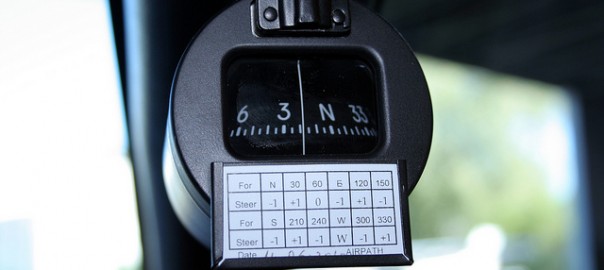Understand how the magnetic compass works, the associated errors, how to correct for these errors, and rate of turns.
Have you ever walked with a bowl of soup? When you turn, how does the soup turn? This is similar to a compass: rigidity in space.
In an Emergency without the AHRS, you will need to use the compass for headings given by ATC.
Definitions:
Variation: caused by the difference in the physical location of the magnetic north pole and the geographic north pole.
Deviation: caused by local magnetic fields within the aircraft. Deviation error is different on each heading
Standard Rate Turns: 3°/second turns in heading.
Errors:
Variation: caused by the difference in the physical location of the magnetic north pole and the geographic north pole.
- Does it affect me as an IFR pilot? No—we don’t use true north
Magnetic or True?
- IFR charts? Magnetic
- VOR Magnetic
- GPS? Magnetic
- Runways? Magnetic

Deviation: caused by local magnetic fields within the aircraft. Deviation error is different on each heading
- Deviation card shows what the mechanics are unable to correct/adjust
- Used mainly for setting directional gyro. If electrics fail/off, the heading is not accurate because it has been corrected for the magnetic interference on the ground
Magnetic Dip: indication errors caused by an unbalanced compass
- Teeter-totter balance analogy– at the magnetic equator north and south forces are balanced. Increase latitude, north pole is pulling down more than south pole
- Above 60° latitude, compass is unusable—too much dip
ANDS: Accelerate North, Decelerate South—this is what the compass does, caused by inertial forces
UNOS: Undershoot North, Overshoot South.
Rule of thumb: latitude minus turn out (half your bank angle in degrees heading as usual). Utah ~40° latitude: 40°-10° (20° bank)=30° for Northerly headings. 20° for 330 and 030, 10° for 300 and 060
Standard Rate Turns: 3° heading/second: 2 minutes for 360° turn
- Bank angle required: Standard rate turns: 15% of TAS or ~20% IAS (easier to calculate)
- TAS: 2% per thousand feet indicated
- Compass limitation: 16°-20° bank becomes unusable—compass measures the horizontal plane
|
Bank angle for turns: |
In White Arc |
Out of White Arc |
|
Compass (standard rate) |
10° |
15° |
|
Timed (1/2 standard rate) |
5° |
10° |
Standard Rate Turns—Set easy rule based on airspeed
- Within white arc: 10° bank
- Above the white arc: 15° bank
Timed Turns (less than 30°heading change)—Set easy rule based on airspeed: use half standard rate:
- Within white arc: 5° bank
- Above the white arc: 10° bank
|
Calculations |
Standard Rate |
½ Standard rate |
|
360° |
2 min |
4 min |
|
360°/120 sec |
3°/sec |
6°/sec |
|
Change of Heading |
Standard Rate |
½ Standard rate |
|
10° |
3 sec |
6 sec |
|
30° |
9 sec |
18 sec |
|
Quick/Easy Calculation |
Heading times 3 drop zero for seconds |
Heading times 6 drop zero for seconds |
|
Quick estimation |
Standard: 30 (degrees) in 10 (seconds) |
Half-standard: 30 (degrees) in 20 (seconds) |
Gyroscopic instruments—Attitude Indicator
- Rigidity in space
- Gyroscopic precession

